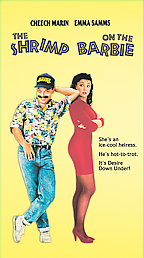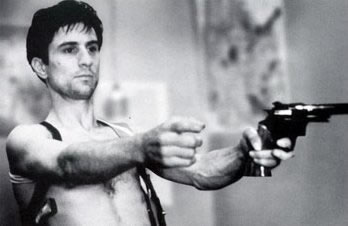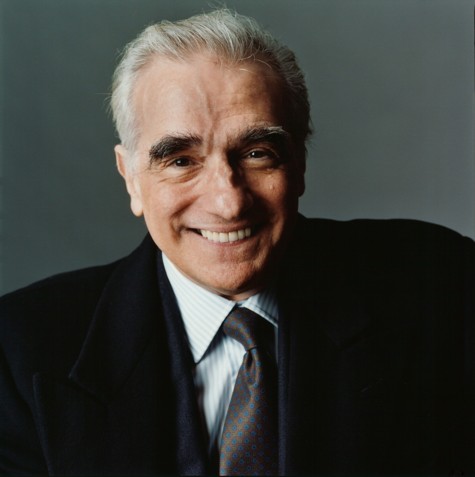|
act: A division within a film. A film is oftentimes divided by plot points or places
of dramatic change, these usually mark the acts.
action: Any movement that takes place before the camera to move along the story.
Also the phrase directors use to set a scene in motion while filming.
actor: Any male who performs the role of a character in a movie. Notable actors
in cinema history are: James Stewart, John Wayne, Humphrey Bogart, Cary Grant, Jack Nicholson, Robert De Niro and Tom Hanks.
actress: Any female who plays the role of a character in a movie. Notable actresses
in cinema history are Audrey Hepburn, Bette Davis, Ingrid Bergman, Katharine Hepburn, and Meryl Streep.
actualities: An old tern for a documentary
adaptation: One art form presented through another art form. Movies are adapted
from stage plays, books, history, comic books, and television shows. Notable adaptations from novels to movies are "The Grapes
of Wrath," directed by John Ford and adapted by John Steinbeck's novel and "Gone with the Wind," directed by Victor Fleming
adapted by Margaret Mitchell's novel.
ad lib: Dialogue that is improvised by an actor either deliberately or on accident.
aerial shot: A shot filmed from a helicopter or an airplane.

Alan Smithee: The pseudonym used by directors who want to be disinvolved from a
film for which they no longer want to be credited for. It was used when the director could prove to the satisfaction of the
Director's Guild that the film had been taken from his/her creative control. The director was required to keep the reason
for the disinvolvement secretive. Alan Smithee is an anagram for The Alias Men. The name originated as a result of the 1969
film "Death of a Gunfighter." The film's star Richard Widmark and director Robert Totten had creative differences
and Widmark wanted Totten replaced. Totten was replaced by Don Siegel. Upon the film's completion Siegel felt that Totten
had done more work on the film and refused to take credit for the film. The film was credited to the fictitious Alan Smithee
for the first time. After the release of the 1998 comedy "An Alan Smithee Film: Burn Hollywood Burn," starring Eric Idle,
the Director's Guild stopped the practice of using the name Alan Smithee for film's in which director's no longer wanted credit.
Notable films directed by the fictitious Alan Smithee are "Death of a Gunfighter," (1969) "The Shrimp on the Barbie" (1990)
(pictured), and "Hellraiser: Bloodline" (1996).
A List: The top actors/actresses in Hollywood. Those sought out by studios because
they are box office gold. Examples of A listers are Tom Hanks and Julia Roberts.
allegory: A representation of an abstract or spiritual meaning through concrete
or material forms
allusion: A direct or indirect reference through an image or dialogue. Example:
The cross formed by the roads at the end of "Cool Hand Luke" is often thought as an allusion to Paul Newman's leading
character as being a Christ-like figure.
alternate ending: A seperate ending shot or re-shot for the film's theatrical release;
usually because a film's ending didn't test well for preview audiences.
ambiance: Feeling or mood of a scene or setting.
angle: Perspective in which the camera depicts its subject.

animation: A process in which inanimate, static objects or individual objects are
filmed frame by frame as oppsed to being shot live. Each image differs slightly from the previous one to create the illusion
of movement. Notable animated films are "Snow White and the Seven Dwarfs" (1937) (pictured), which was Disney's first
full length animated film. Other animated films include "Beauty & the Beast" (1991), "The Lion King" (1994), and "Toy
Story" (1995).
anime: Style of animated film that has its roots in Japanese comic books. Anime
entered into the mainstream in Japan in the 1980s and began being internationally accepted in the 1990s.
antagonist: A person who is opposed to, stuggles against, or competes with another;
opponent or adversary.
anthology film: A multi-part film with a collection of series of various tales linked
with a theme or tale.

anti hero: The main protagonist who lacks attributes or characteristics of a typical
hero, but with whom the audience indentifies with. Character is often a confused or conflicted one. Examples of anti heros
in film are Travis Bickle as played by Robert De Niro in 1976's "Taxi Driver" (pictured), Jim Stark as played by James Dean
in "Rebel Without a Cause" (1955), and Randle Patrick McMurphy as played by Jack Nicholson in "One Flew Over the Cuckoo's
Nest" (1975).
aperture: The place where individual frames are exposed.
arc shot: A shot in which the camera circles the subject or subjects being filmed.
armorer: The person responsible for weapons used on the set of a movie.
art house film: Films that are acknowledged as being artistic. Art house films are
usually low budget, foreign, independent, non-mainstream, documentaries, or erotic films.
aside: When a character breaks the fourth wall and addresses the audience directly.
aspect ratio: How the image appears on the screen based on how it is shot. Width
to height of a film frame.
assembly: The first stage of film editing in which all shots are arranged in order
of the script.
atmosphere: Any concrete quality or feeling contributing a dimensional tone to the
film's action. Example: The downpouring rain that can be heard from the outside in Sidney Lumet's 1957 film "12 Angry Men."
audition: Practice by which an actor reads or performs for a director or casting
director in efforts to win a role in a film.

auteur: French for author. Theory which states that the director is the author for
the film, not the screenwriter. Auteur theory denotes a critical theory. It was introduced by Francois Truffaut in France
and influenced such American filmmakers as Martin Scorsese (pictured) and Francis Ford Coppola. Responsible for the creation
of film with personal vision, style, thematic aspects, and technique specific to that director.
available light: Naturally exsisting light in or off-set location. Realism is enhanced
by using available or natural light instead of artificial light.
Avant-garde: Experimental, abstract, or highly independent. Emphasizes technique
over substance; challenges conventional filmmaking.
|